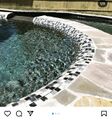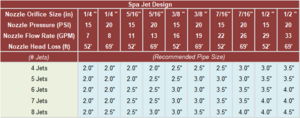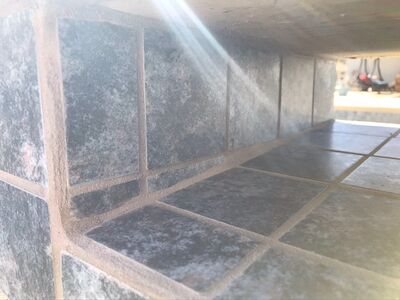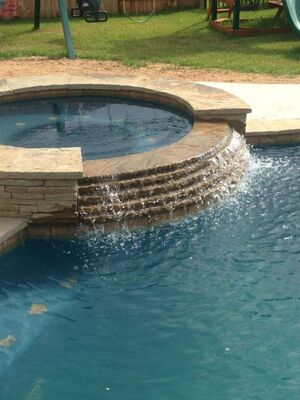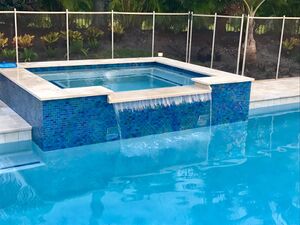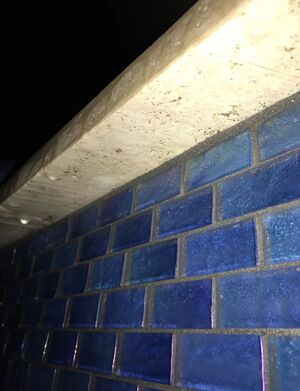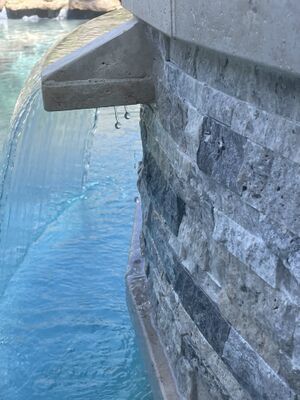Gunite Spa Design
Closing the Comfort Gap in Spas - Aqua Magazine gives a good overview of what is possible.
If you want a good number of spa jets and high water pressure from the jets then a dedicated spa jet pump that is not going through the restrictions of the filter and heater plus the proper large size pipes is needed to get the necessary GPM flow.
For example, with 8 jets you want to be able to flow 120 GPM. That requires at least 3" suction and 2.5" return to spa jets although I would do 3" to spa jets.
| Pipe Size | 6 ft/sec | 8 ft/sec |
|---|---|---|
| 1.5" | 38 GPM | 51 GPM |
| 2" | 63 GPM | 84 GPM |
| 2.5 | 90 GPM | 119 GPM |
| 3.0" | 138 GPM | 184 GPM |
Spa Seat Design
Its not uncommon to have angled back rests, foot supports and rolled bond beams. There really is no limit to what is possible.[1]
Attached spas are 100% customizable. A spa was built for a very picky lady. She put on a tyvek suit and lay in the wet plaster in the spa so it was contoured to her body.
The bottom line is you can get whatever you ask and are willing to pay for.
Spa Coping
Consider doing a rolled tile edge on the spa instead of the traditional overhang coping.[2]
Spa Jets
Paramount ParaJets massage therapy spa jets allows the ability to change or move the therapy jet faceplates to different stations in your spa with a simple twist. ParaJets offer 4 interchangeable massage therapy jet faceplates; Deep Tissue, Shiatsu, Pulsating or Soft Stream.
Spa Jet Design
The first step in designing a spa is to settle on the number of jets, size of jet and how strong you would like the jet to feel. Once this is determined, the following table can be used to determine the proper pipe size and the resulting operating point for the pump.[3]
The following example will help understand how to use the sizing table:
- Jet Design: 6 x 3/8" Jets @ 15 GPM/Jet
- Total Flow Rate = 90 GPM
- Minimum Recommended Pipe Size = 3.0"
- Head Loss ~ 37' (assumes 100' of pipe and typical fittings for a spa)
- Desired Pump Operating Point = 90 GPM @ 37' of head
Spa Air Bubbles
Some spas get air bubbles into the jets through a venturi system pulling air through an open pipe. Other spas use a powered Spa Air Blower for bubbles through the jets.
The Paramount Air- Port is a muffled air intake that can be installed in the deck near the spa. The Air-Port eliminates the need to run extended air intake lines and thereby eliminates the problems associated with flooded lines.
Spa Spillway
A gunite spa may have a spillway for water to flow into the pool.
The negative wall design of the spillway pictured below keeps the tile in the spillway under water when the pump is off or spa spillover not running and the tile is not exposed to air and evaporation.[4]
The picture is looking from the spa to the pool. Take note at the bottom of the tile line as it has deeper water at the spa than at the ending point spillway to the pool.
Spa Spillover
A raised spa may have a spillover for water to flow from the spa to the pool. The spillover material can be stone or tile. The material, shape, and size of the spillover determines the way the water flows over.
The wider a spillover is, the more water flow you will need for a smooth waterfall effect over the spillover.
If you have a ledge then surface tension can cause the water to wrap around the ledge and back to the tile. The fix is to put a notch sawcut/groove under the edge of the ledge to break the surface tension and have the water fall away.
The notch should be 1/4" deep about 1/4" back from edge. The picture below shows a ledge spillover with a drip because it lacks the notch.
Gunite Spa Repairs
- ↑ https://www.troublefreepool.com/threads/gunite-spa-seat-shaping-contouring.187867/post-1661222
- ↑ https://www.troublefreepool.com/threads/thoughts-on-rolled-tile-edge-for-spa.228592/
- ↑ https://www.troublefreepool.com/threads/hydraulics-101-have-you-lost-your-head.830/
- ↑ https://www.troublefreepool.com/threads/perimeter-overflow-spa-question.242885/post-2128621





